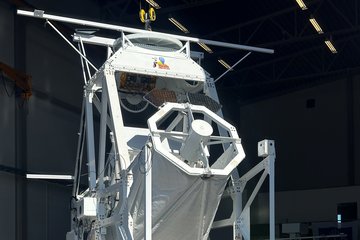All genres
1.
Journal Article
Cosmic-ray propagation properties for an origin in supernova remnants. Astrophysical Journal 619 (1), pp. 314 - 326 (2005)
2.
Journal Article
On the determination of energy spectra of MeV electrons by the Ulysses COSPIN/KET. Advances in Space Research 35 (4), pp. 605 - 610 (2005)
3.
Journal Article
Stellar wind regimes of close-in extrasolar planets. Astronomy and Astrophysics 434, pp. 1191 - 1200 (2005)
4.
Journal Article
MHD simulations of the solar wind interaction with Mercury. Journal Geophysical Research 107 (A11), 1348 (2002)
5.
Journal Article
Resistive MHD simulations of Ganymede's magnetosphere 2: Birkeland currents and particle energetics. Journal Geophysical Research 107 (A12), 1491 (2002)
6.
Journal Article
Resistive MHD simulations of Ganymede's magnetosphere 1: Time variabilities of the magnetic field topology. Journal Geophysical Research 107 (A12), 1490 (2002)
7.
Journal Article
Magnetisation of partially ionised dusty disks. Journal of Plasma Physics 66 (8), pp. 213 - 222 (2001)
8.
Journal Article
On ion outflows from Titan's exosphere. Geophysical Research Letters 28 (17), pp. 3405 - 3408 (2001)
9.
Journal Article
Asymmetric mass loading effect at Titan's ionosphere. Journal Geophysical Research 106, p. 8323 (2001)
10.
Journal Article
Pluto's ionospheric models and solar wind interaction. Advances in Space Research 26 (10) (10), pp. 1559 - 1563 (2000)
11.
Journal Article
Pluto's ionospheric models and solar wind interaction. Advances in Space Research 26 (10) (10), pp. 1559 - 1563 (2000)
12.
Journal Article
Magnetospheric ion sputtering: The case of Europa and its surface age. Advances in Space Research 26 (10), pp. 1649 - 1652 (2000)
13.
Journal Article
A three-fluid system of equations describing dusty magnetoplasmas with dynamically important dust and ion components. Physics of Plasmas 7 (8), pp. 3468 - 3471 (2000)
14.
Journal Article
The influence of mass loading effects on the electrodynamical interaction between Jupiter and Io. Advances in Space Research 21 (11), pp. 1475 - 1478 (1998)
15.
Journal Article
On the formation of Io-related Jovian discrete auroral phenomena. Advances in Space Research 21 (11), pp. 1469 - 1473 (1998)
16.
Journal Article
On the formation of Io-induced acceleration regions related to Jovian aurora. Planetary and Space Science 46, pp. 405 - 415 (1998)
17.
Journal Article
MHD simulations of large conducting bodies moving through a planetary magnetosphere. Physica Scripta T74, pp. 71 - 76 (1998)
18.
Journal Article
DENISIS - A three-dimensional partially ionized dusty magnetoplasma code. Computer Physics Communications 112, pp. 7 - 22 (1998)
19.
Journal Article
Some remarks on the generation and dissipation of magnetic fields in dusty plasmas. Physica Scripta T74, pp. 82 - 85 (1998)
20.
Journal Article
Fluid equations governing the dynamics and energetics of partially ionized dusty magnetoplasmas. Physics of Plasmas 4, pp. 4414 - 4418 (1997)











